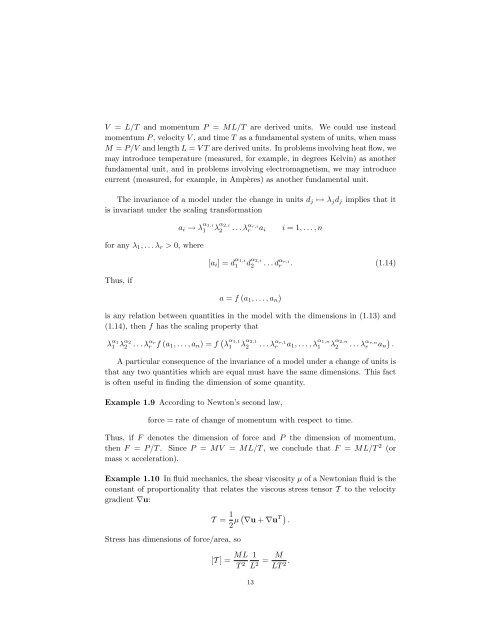Asymptotic Analysis and Singular Perturbation Theory
Asymptotic Analysis and Singular Perturbation Theory
Asymptotic Analysis and Singular Perturbation Theory
Create successful ePaper yourself
Turn your PDF publications into a flip-book with our unique Google optimized e-Paper software.
V = L/T <strong>and</strong> momentum P = ML/T are derived units. We could use instead<br />
momentum P , velocity V , <strong>and</strong> time T as a fundamental system of units, when mass<br />
M = P/V <strong>and</strong> length L = V T are derived units. In problems involving heat flow, we<br />
may introduce temperature (measured, for example, in degrees Kelvin) as another<br />
fundamental unit, <strong>and</strong> in problems involving electromagnetism, we may introduce<br />
current (measured, for example, in Ampères) as another fundamental unit.<br />
The invariance of a model under the change in units dj ↦→ λjdj implies that it<br />
is invariant under the scaling transformation<br />
for any λ1, . . . λr > 0, where<br />
Thus, if<br />
ai → λ α1,i<br />
1 λα2,i 2 . . . λ αr,i<br />
r ai i = 1, . . . , n<br />
[ai] = d α1,i<br />
1 d α2,i<br />
2 . . . d αr,i<br />
r . (1.14)<br />
a = f (a1, . . . , an)<br />
is any relation between quantities in the model with the dimensions in (1.13) <strong>and</strong><br />
(1.14), then f has the scaling property that<br />
λ α1<br />
1 λα2 2 . . . λαr<br />
r f (a1, . . . , an) = f λ α1,1<br />
1<br />
λα2,1 2<br />
. . . λ αr,1<br />
r<br />
a1, . . . , λ α1,n<br />
1 λ α2,n<br />
2<br />
. . . λ αr,n <br />
r an .<br />
A particular consequence of the invariance of a model under a change of units is<br />
that any two quantities which are equal must have the same dimensions. This fact<br />
is often useful in finding the dimension of some quantity.<br />
Example 1.9 According to Newton’s second law,<br />
force = rate of change of momentum with respect to time.<br />
Thus, if F denotes the dimension of force <strong>and</strong> P the dimension of momentum,<br />
then F = P/T . Since P = MV = ML/T , we conclude that F = ML/T 2 (or<br />
mass × acceleration).<br />
Example 1.10 In fluid mechanics, the shear viscosity µ of a Newtonian fluid is the<br />
constant of proportionality that relates the viscous stress tensor T to the velocity<br />
gradient ∇u:<br />
Stress has dimensions of force/area, so<br />
T = 1<br />
2 µ ∇u + ∇u T .<br />
[T ] = ML<br />
T 2<br />
1 M<br />
= .<br />
L2 LT 2<br />
13
















